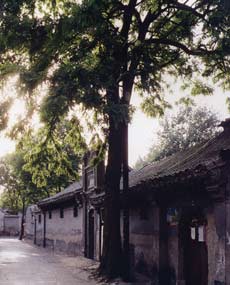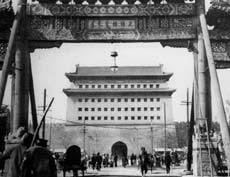| Protecting the Old Capital |
| http://www.sina.com.cn 2005/04/11 18:29 thats China |
|
A Tough Task
How to modernize Beijing while protecting the old capital has been a stubborn problem ever since the city first laid out its development plans in 1949. In 1950, Liang Sicheng, the founder of modern Chinese architecture, together with celebrated architect Chen Zhanxiang proposed a design that suggested building a new city center in the western suburbs of Beijing in order to give room for the development of the new city while preserving the old capital at the same time. In opposition to Liang and Chen's plan was that of Zhao Dongri. Zhao suggested establishing the Communist government's administrative center around today's Zhongnanhai area (just west of the Palace Museum) and make full use of the Old City's construction, thus maintaining the area's prosperity rather than consigning it to disuse and decline. In the end, the government accepted Zhao's plan. If Liang and Chen's plan had won out, a well-constructed ancient capital might have been preserved intact. However, history allows no hypotheses. The large expense of preserving and restoring the Old City may have proven prohibitive. After 40 years, Zhao still believes his plan was the best choice. "There were about 170 million square meters of traditional construction in 1949. The economic conditions at the time didn't allow us to keep the old city intact but rather use it to build a new city."
The old capital took on a new face as Zhao's plan was put into action. More and more buildings of historical significance gave way to the development of the new city. In the 1950s, the outer city towers were completely pulled down. In 1965, the eradication of the inner city walls was begun to allow for the construction of a subway line. Today, stops on Line 2 of the Beijing subway, such as Xizhimen, Dongzhimen, Fuchengmen, and Chaoyangmen, all mark spots where former entrances to the Old City have been replaced with crowded downtown districts. As Beijing accelerates its urbanization, the contradictions between protecting the Old City and further developing it become increasingly acute. The four districts of the Old City are making efforts to boost their business centers. Dongcheng District is developing the Wangfujing Business Center, the Xicheng District is facilitating the progress of the Xidan Business Center and the Financial Street near Fuxingmen, and the Chongwen and Xuanwu Districts respectively, are quickening the pace of business center construction surrounding Chongwenmenwai Dajie and Caishikou Dajie. These developments have laid waste to large swaths of former hutongs. The construction of the Financial Street in Xicheng District, for example, resulted in the demolition of the Mengduan Hutong, which in December 2004 disappeared forever from the modern maps of Beijing. Even the 35th courtyard of the Mengduan Hutong, praised as "the most excellent among the 260 courtyards that I have visited" by Shan Jixiang, Director General of the State Administration of Cultural Heritage, couldn't avoid the bulldozer. Traffic is another problem at the forefront of city planning since 1980. In order to help solve it, the second, third, fourth, and fifth ring roads were constructed around the city center. But in the Old City, traffic is still high and solutions are few. As a last resort, the city government has turned to broadening the narrow hutongs.
Overcrowding and disrepair have also made Beijing's once pleasant courtyard homes lose their attractiveness. From the 1960s on, single courtyard residences often became home to several families, turning the courtyards into compounds. The ample yards were nibbled up by small kitchens; various odds and ends began to pile up in the open spaces. Many of these old courtyards began to subsequently fall into dangerously poor condition. Hutong dwellers either lack the will to maintain and renovate their homes or lack the money to, which opens up the possibility of demolition at the hands of real estate developers looking to build modern high-rises. Xu Chengbei, a scholar of old Beijing culture, admits that there are various difficulties when it comes to protecting these areas. "In most places, there are several households sharing one courtyard and the legal owners of the house are not very clear. The infrastructure and facilities there are quite poor," he says. "It is impossible to protect all of the courtyards in the Old City," Xu adds. "The appeals of scholars are not enough. The effort needs the cooperation of government, developers of real estate, and various social groups."
|
|
|
|
|
|
| Annotation |
| 新 闻 查 询 |
| 热 点 专 题 | ||||
| ||||
|
教育频道意见反馈留言板 电话:010-82628888-5747 欢迎批评指正
新浪简介 | About Sina | 广告服务 | 联系我们 | 招聘信息 | 网站律师 | SINA English | 会员注册 | 产品答疑
Copyright © 1996 - 2005 SINA Inc. All Rights Reserved
版权所有 新浪网![]() 北京市通信公司提供网络带宽
北京市通信公司提供网络带宽


